Just a person learning Japanese. Self-learner. If you're also studying Japanese and want to practice with someone (and you're also very much a beginner) then message me! はじめまして! さびーなです。よとしく!
196 posts
Latest Posts by earthquakedeer - Page 4

行きます|つもり|ようと思う Hey guys, it’s been a while since I’ve made a post on this blog! I’ve been so busy with university and then as soon as my last exam was over I traveled back home to see my family! I finally have some time to myself so I thought I’d make a new post! This is all about how to say doing something in Japanese. This post won’t go into too much depth regarding these sentence patterns, so feel free to look them up for more information on how to use them! 行きます・Going to do: To say, “I’m going to__” in Japanese, you can follow this sentence pattern. Sentence pattern = subject+を+verb stem (ます form without the ます) +に+行きます・行く。 e.g. 何をしますか? What are you doing? 映画を見に行きます。 Going to see a movie. つもり・Plan to do: But what about how to say you intend on doing something, or you plan on doing something? In that case, you can use つもり! Sentence pattern = verb dictionary form+つもり+です・だ。
e.g. 明日は何をしますか? What will you do tomorrow? カラオケに行くつもりです。 I intend to go to karaoke. ようと思う・Think I’ll do: To say that you’re thinking of doing something, you can follow this sentence pattern: Sentence pattern = verb volitional form+ようと思う e.g. で今晩こそ早く寝ようと思う。 I think I’ll go to sleep early tonight.




A small list of verbs! Tomorrow I will post a note sheet for conjugating verbs. For now, just remember that ます is present tense when dealing with verbs.


Days of the week with time grammar! A way I was taught to remember them is with the mnemonic “nine green kangaroos stole my kid’s dog.” If you have any questions, feel free to ask


Here are some colors, a couple vocab, and grammar! Sorry I haven’t been posting much lately. School has been pretty busy. I plan on trying to make daily posts though!

days of the month!The top with the number is how they are normally written out. The hiragana and kanji are how to say them. If you need any help let me know!

There are two forms of sentence structure you can use with prepositions.
topic は something の position(preposition) に あります・います
something の position に subject が あります・います
![[417] かもめ | kamome | seagull](https://64.media.tumblr.com/c1e7646b3a14595b185694f8ea9cd4e0/tumblr_otlts67fAZ1v0vbxgo1_500.png)
[417] かもめ | kamome | seagull
![[419] くじゃく | kujaku | peacock](https://64.media.tumblr.com/3480686cba77cfcf0de07e5532426978/tumblr_otpc0v9Xgp1v0vbxgo1_500.png)
[419] くじゃく | kujaku | peacock
Just my luck
In Japanese this phrase is ついてない and is used the same in English
例えば:
A:今日は雨が降りそうね B:ついてないな
![[249] かみなり | kaminari | thunder](https://64.media.tumblr.com/f6ce16cf37fff9d1a85576c2a2b3ac6e/tumblr_ohd40hQDjJ1v0vbxgo1_500.png)
[249] かみなり | kaminari | thunder
langblrs ♡
if you’re a langblr that posts Japanese, Swedish or Italian content please reblog ~ I want to follow you ~(^з^)-♡
Learning how to study:
Understand that studying is not the same as doing homework.
Create a study plan.
Making a timetable.
Have a good study space.
Manage your time.
Guide to bullet journals.
How to prioritise tasks
A guide to different planners
Apps for scheduling
Take effective notes.
Guide to note taking.
Taking Notes that Work (article by Dustin Wax)
Colour coding your notes
Taking lecture notes visual (by strive-for-da-best)
Getting the most from lectures
An example of Cornell notes (by overmycoldcoffee)
Read text before and after class.
SQ3R Reading
Study smart.
Guide to studying with mindmaps
Visual guide to mindmaps
The Pomodoro technique
Feynman Technique
How to Hermione the Shit out of your studying (byhermionetheshitoutofstudy)
Things top students do (by study-studymore-studyhard)
Learning how to learn (by strive-for-da-best)
Use test taking strategies.
Maintain your studies.
Manage your stress.
Getting a good night’s sleep
Stress relief techniques and ideas
23 Science Backed Ways to Reduce Stress
25 Destressing Techniques
Failure anxiety
Do nothing for 2 minutes
Calm (meditation site)


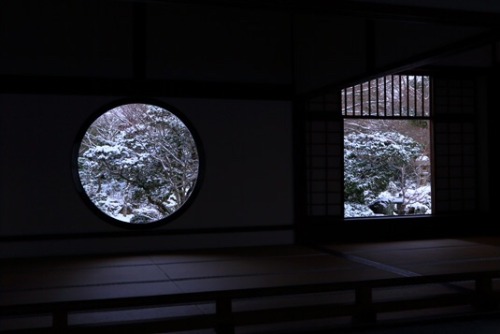
Genko-an Temple (Kyoto,JAPAN)
Summer/Fall/Winter
Reblog if you’re a studyblr
I’m a new studyblr and I need to follow more people! Please reblog if you post at least 80% studyblr :)
english: one million
japanese: :)
english: oh boy
japanese: one hundred ten thousands

for study snack day of the October Study Challenge, here’s the apple spice mug cake recipe I mentioned here!
Ingredients:
2 tbsp (30g) all purpose flour
¼ tsp baking powder
2 tsp granulated sugar
1 ½ tbsp (22.5ml) milk
1/8 tsp ground cinnamon
2 tbsp (30g) applesauce
2 tbsp (16g) chopped apples
Directions:
put all ingredients except apples into microwave safe mug
mix with fork until smooth
stir in apple cubes!
cook in microwave for about one minute. (if needed, cook for additional 15 seconds)
sprinkle a little more cinnamon on top and eat! (careful, it’s hot!)
Notes:
try to use a sweeter variety of apple, otherwise your cake will come out a little tart. cut the apple into cubes about ½ inch in size.
for an extra treat, scoop on some ice cream or add whipped cream!
feel free to mess around with the amounts a little to get the texture and flavour you like the most - there’s a whole bunch of recipes for cakes just like this out there on the internet!
Japanese Vocabulary : Using your phone in Japanese
[FRENCH BELOW]
This list is not complete, I will update it from time to time when I can ! Please note that I’m using a Samsung Galaxy S7 and there might be slight differences depending on the phone you have.
I will not put the terms written in katakana, as 1) you should know them 2) their meaning is usally easy to guess since most of the time they’re english words.
PS : If you’re learning French, note that there are quite a few words / expressions that are abbreviated !
PS2 : Also note that I put my phone back in English and French to get the best translations, but some words are “computer terms” so please check before using them in another context :)
I hope this will be useful :)
Cette liste n’est pas complète, je la mettrai à jour quand je pourrai! Prenez en compte le fait que j’utilise un Samsung Galaxy S7, donc il se peut qu’il y ait quelques différences avec d’autres téléphones.
Je ne mettrai pas les termes écrits en katakana : 1) vous devriez les connaître 2) si vous comprenez l’anglais leur sens est normalement simple à trouver, sinon il suffit d’aller chercher la signification (ce qui est bien plus facile que de chercher des kanjis qu’on ne connait pas…)
PS : J’ai remis mon téléphone en anglais et en français pour avoir la meilleure traduction, mais faîtes attention car certains mots sont des termes réservés à l’électronique et pourraient ne pas fonctionner dans un autre contexte !
ロックを解除(かいじょ)するには、スワイプしてください : Swipe screen to unlock / Faîtes glisser votre doigt sur l’écran pour déverrouiller.
機内(きない)モード : Airplane mode / Mode hors-ligne
省電力(しょうでんりょく) : Power saving / Eco. énergie
縦画面(たてがめん) : Portrait / Portrait
自動回転(じどうかいてん) : Auto rotate / Rotation auto.
位置情報(いちじょうほう) : Location / Position
全(すべ)て消去(しょうきょ) : Clear all / Effac. tout
通知設定(つうちせってい) : Notification setting / Param. notif.
電卓 (でんたく) : Calculator / Calculatrice
翻訳 (ほんやく) Translate / Traduction
連絡先 (れんらくさき) Contacts / Contacts
時計 (とけい) Clock / Horloge
電話 (でんわ) Phone / Téléphone
予約 (よやく) Schedule (a message) / Programmer (un message)
削除 (さくじょ) Delete / Supprimer
画像 (がぞう) Pictures / Photos
検索 (けんさく) Search / Rechercher
編集(へんしゅう) Edit / Modifier
全てを朗読(ろうどく)にする Mark all as read / Tout marquer comme lu
保護(ほご)メッセージ Locked messages / Messages verrouillés
お問(と)い合(あ)わせ Contact us / Nous contacter
履歴(りれき) Recents / Récents
作成(さくせい) Compose / Rédiger
番号 (ばんごう) Number / Numéro
入力 (にゅうりょく) Enter (a text) / Rédiger
共有 (きゅうゆう) Share / Partager
追加 (ついか) Add / Ajouter
非表示 (ひひょうじ) Hide / Masquer
貼(は)り付(つ)け Paste / Coller
作 (さく) Notes / Notes (Tumblr, Instagram…)
保存 (ほぞん) Save / Enregistrer

Sometimes, when we are presenting, our bodies act completely irrationally. Sweating, stuttering, or just shutting down completely are all things I have encountered during public speaking; behaviour that is usually connected to extreme danger and fleeing behaviour. Completely unnecessary, as your teacher won’t kill you (hopefully), but trying to convince your body to be just as rational is a tough task. Turns out that this is exactly what we’re going to do.
The basis for this (personal) advice all lies in my musical training, where posture is extremely important. Performance practice lessons have taught me one important thing: you can trick your body into thinking it’s okay, and with that, your audience. disclaimer: I have posted this information before in a slightly different way. Regard this as an updated version. Hopefully one with better spelling.
hoooooow???
Stand up and try to follow these instructions. I’m your only audience right now, so mistakes aren’t a problem.
Start by relaxing your shoulders. Many people tense their shoulders when they’re anxious, which is a very natural reaction. However, tension in your shoulder automatically reaches through to your back and arms, and even your neck, tensing up your entire upper body. It’s confirming to your brain that yes! this is scary! Well, brain is wrong and we’re going to prove it wrong by relaxing our shoulders. Just let them hang down (make sure you don’t start leaning forward though, it should be just your shoulders). Doesn’t that immediately feel more relaxed?
Keep your feet a little bit apart, firm on the ground. This sends the message to your brain and audience that a single push will not have you fall over. Standing with your legs closely together simply isn’t as stable, and you want to radiate stability and confidence. Even if you’re feeling dizzy, this simple way of pretending will keep your feet on the ground. Literally.
Chin up, back straight, eyes at the audience. I used to tend to look at the ground, or to lean forward. No, no no! You want to maintain an open posture, and to address the entire audience. When you do this, you’ll look more secure, and maybe you’ll even notice people will listen to you more closely. Make sure you address the entire room, and not just one spot. if you’re scared to look at faces, look at the back wall. But not just one spot, find some nice different wall spots to look at.
What to do with your hands? I know I used to put my hands in my pocket, or fidget with something. Instead, try to talk with your hands more. When you’re using gestures, people will usually pay more attention to what you’re saying, and they’ll sometimes understand more easily (if you’re interested as to why, message me).
Do not hide. This is special advice to musicians, too. I used to hide behind my music stand because it was nice and safe. During public speaking it’s easy to hide behind some notes or to stand behind other people of your group, maybe. Don’t. Remember, fake the confident posture till you make it.
When you’re finished, don’t stop pretending just yet. When people ask how it went, always say it went okay. This is so so so important! Because if you’d say “ugh it was awful!! So many things went wrong, I suck at presenting!” they’ll start thinking hmm, yeah, there were indeed some mistakes… Could have been better. Whereas if you just say it was okay or good, or even decent, they’ll hardly even question it and will most likely remember the positive aspects, as humans tend to do.
I promise this works, at least to some extent. It may not help you get rid of anxiety right away, especially in really severe cases, but it can help you feel more at ease in front of a group. After that, you can start working on other things, such as volume, intonation, powerpoint use etc.
Just take a few seconds before you start talking to breathe, focus on those muscles, and to follow this with an amazing presentation (and a good grade).
You can always send me an ask for advice on public speaking! Even though I’m not a professional coach or whatever, I have overcome my speaking anxiety and maybe I can be of any help at all <3


This simple challenge is for anyone who is trying to learn a language. Every day of November, try to write a sentence or small paragraph containing all of the words for that day! You may conjugate all you want, you may use several more nouns/verbs/adjectives, as long as the prompted words are there and recognizable.
Post to tumblr or write for yourself! And don’t forget to tag with your language and #NVA November, so that others may help and correct you, and so we can see if it’s possible to make weirder sentences than Duolingo.
Vocabulary list below.
Keep reading
Japanese lesson: In the morning
朝 (asa) - morning あくび (akubi) - yawn 疲れた (tsukareta) - tired 目覚まし時計 (mezamashi dokei) - alarm clock 布団 (futon) - bed 夜明け (yoake) - dawn 寝坊 (nebou) - oversleep 朝ごはん (asagohan) - breakfast 眠たい (nemutai) - sleepy 起きたくない (okitakunai) - I don’t want to get up.. おはよう (ohayou) - Good morning! ベッドから出られない (beddo kara derarenai) - I can't get out of bed.

Guide to Self-Studying Japanese
A large proportion of Japanese learners self-study. Finding places to learn Japanese in a classroom environment can be difficult and expensive. Here’s a guide on how you can learn Japanese for free and from the comfort of your sofa.

When learning Japanese, the most important step is to learn Hiragana and Katakana, the writing alphabets of Japanese.
The best way I’ve found to do that is to make flashcards. Make sure you practice writing as well as recognizing them, this will not only be a great skill to have but will also reinforce the shapes in your mind.
Resources:
[Hiragana 42], the best guide I’ve found to learn the Hiragana (in a day!) [Hiranana and Katakana Quiz Site] [Kana Invaders Game] [Anki] An amazing program that will make sure you never forget any Kana….

The next step is to start learning vocabulary. Where can you find what to learn? Use a site like Memrise to find word lists (for example, there is a word list for all the vocabulary in starter textbooks like Genki), and use the amazing interface to learn them and keep them in your long term memory.
Resources:
[Memrise] as mentioned above to find and learn vocabulary lists. [Most Common Words List] [Anki] An amazing program that will make sure you never forget any Vocabulary….

While encountering vocabulary, you’re likely to be coming across super-complicated-looking Kanji. You can learn Kanji through Memrise as above, but there are some other websites that may be of interest.
Resources:
[Kanji Damage] A great site where you can learn Kanji through mnemonics. [WaniKani] by the same people who make TextFugu can help you learn Kanji from scratch. [Anki] An amazing program that will make sure you never forget any Kanji….

The next step is to apply that new vocabulary to grammar points and start making sentences.
If you can’t get your hands on textbooks like Genki, don’t fear! There are a lot of great online grammar resources.
Resources:
[TextFugu] a highly rated ‘online textbook’ which will guide you right from the beginning of learning Japanese. [Guide to Japanese] another online textbook with a lot of grammar points and excellent explanations.

So you probably started to learn Japanese because you have some interest in Japanese media. Time to start using it to your advantage!
Aside from the obvious watching Anime, J-dramas and films, why not try Reading Japanese News? Watching Japanese TV? Just make sure you are making these activities productive - note down new vocabulary, add them to Anki, and keep learning! It’s much easier to learn things you’re interested in.

The most important but difficult part of self-studying Japanese is getting your own compositions checked. Utilize all that grammar and vocabulary and write a short piece, it could be a diary entry or a short essay. Get it recorded for you by a native on RhinoSpike, and checked for grammar and consistencies on Lang-8.These sites also give you the chance to connect with Japanese natives, and perhaps start up some language exchanges!
For more resources, take a look at my Ultimate Resources List
Any more tips? Please submit them here!




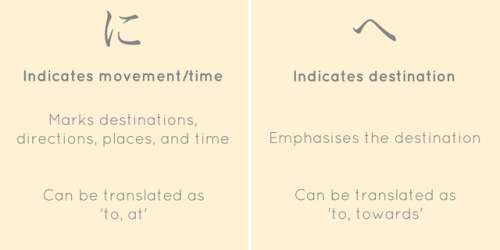
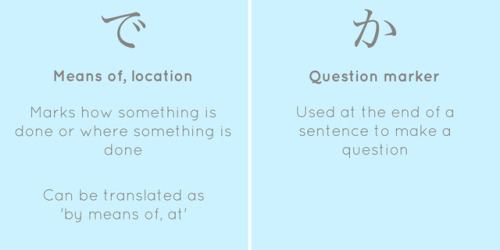
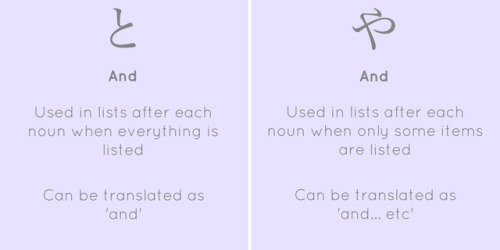
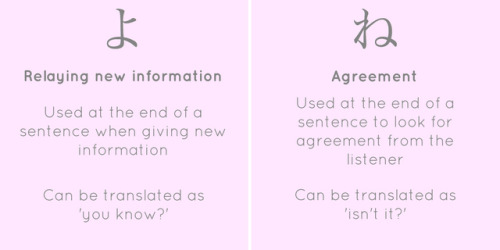
I’ve been meaning to make this post for a while, and I got an anon the other day asking about particles and a request from someone to make this post, so here it is! A list of basic particles and their usage! I hope this can help anyone struggling with particles and how to use them, but if I have made any mistakes please let me know ^^ (also please don’t remove my caption!)

I’ve been preparing for the JLPT N5 myself, so I thought I’d make a little list of some of the resources I’ve found!
websites
Nihongo Ichiban N5 Study Material
JLPT Website:
Self Evaluation List
Sample Questions
japanesetest4you JLPT N5 Resources
JLPT Boot Camp
Mock Test
JLPT Study Page (a bit of an older page, but still a good study resource)
Memrise
JLPT N5 Vocab
JLPT N5 Readings
books
Official JLPT Reference Books
Guide to Reading and Writing Japanese Characters (4th Edition)
Compact Japanese Dictionary
Read Japanese Kanji Today
apps (android)
Kanji Study
Obenkyo
Duolingo
Write Japanese: Kanji, Hiragana, and Katakana
Tinycards by Duolingo: Fun & Free Flashcards

Learning Japanese Master Post #02.
Here’s a master post for video lessons #51-#100 in the Learning Japanese video series, all view-able for free on YouTube! That’s right, each topic gets its own episode! All arranged in order and linked below. Check out all 200+ video lessons at the official YouTube channel here and the other Master Posts: 1 3
Conjugations of Desu (です)
Conjugating い-Adjectives
Conjugating な-Adjectives
How-to Say “(I/We) want X” and “Do you want X?” (Xがほしいです)
How-to Say “X wants Y” (Third Person) (XはYをほしがっている) (cont.)
“VERBAL NOUN + に(行く/来る)” as “Going/coming to do VERBAL NOUN”
Using adjectives as adverbs
How-to say “try to do VERB” (VERB て-Form + みる)
How-to say “in order to VERB/for the sake of VERBing” (VERB Dictionary Form + ために)
Potential Form (Verb Conjugation)
て- Form VERB + いる as “has VERB-ed” (Resultant State)
X ので Y as “Because X, Y”
How-to say “VERB while VERBING” with Pre-ますForm VERB + ながら + VERB
How-to use しまう to emphasize finality of an action (て-Form + しまう)
How-to say “to VERB2 without doing VERB1” (Negative ない-Form VERB1 + で + VERB2)
How-to say “it is (easy/hard) to do VERB” with Pre-ます-Form VERB + (やすい/にくい)
The たり-Form - たり-Form V1 + たり-Form V2 + する (Do VERB1, VERB2, and other such things)
The て-Form as “and” (CLAUSE1 + て + CLAUSE 2 as “CLAUSE1 and CLAUSE2”)
X までに as “by the time of X”
How-to say “become (ADJECTIVE/NOUN)” with (ADJECTIVE/NOUN) + なる
How-to say “make X (ADJECTIVE/NOUN)” with X を (ADJECTIVE/NOUN) + する
How-to say “Before CLAUSE1, CLAUSE2” (Dictionary Form C1 + 前に + C2)
How-to say “After CLAUSE1, CLAUSE2” (た-Form C1 + 後で + C2)
How-to say “do nothing but VERB” (て-Form VERB + ばかりいる)
How-to say “VERB nothing but NOUN” (NOUN + ばかり + VERB)
How-to say “start VERBing” (Pre-ます-Form VERB + 始める)
How-to say “finish VERBing” (Pre-ます-Form VERB + 終わる)
(Dictionary/Negative-ない)-Form VERB + ようにする as “make an effort (to/not to) VERB”
(Dictionary/Potential/Negative-ない)-Form VERB + ようになる as “it has become that”
How-to say “I think that” (Plain-Form + と思う)
Volitional Form (Verb Conjugation)
Plain Form + かも知れない as “(may/might/possibly) be _”
(Pre-ます-Form VERB/Stem-Form ADJECTIVE) + すぎる as “(VERB too much/too ADJECTIVE)”
Volitional-Form VERB + と思う as “I think I will VERB”
“A (is/isn’t) as ADJ as B” - AはB(と同じぐらい ADJ/ ほど Negative-Form ADJ)
Plain-Form A + のに + B as “Even though A, B”
AてからB as “After A, B”
Plain-Form + でしょう as “probably ___”
How-to say “should do VERB/it’s best to do VERB” (た-Form VERB + 方がいい)
How-to say “should not do VERB/it’s best to not do VERB” (ない-Form VERB + 方がいい)
Conditional ば-Form (Verb Conjugation + Adjective and Noun Conjugation)
ば-Form CLAUSE1 + CLAUSE2 as “If CLAUSE1, CLAUSE2”
Negative ば-Form (なければ) CLAUSE1 + CLAUSE2 as “If not CLAUSE1, CLAUSE2”
たら-Form: C1たらC2 as “After C1, C2” or “If C1, C2” (pt. 1 of 2)
たら-Form: C1たらC2 as “After C1, C2” or “If C1, C2” (pt. 2 of 2)
(Pre-ます-Form VERB/Stem-Form ADJ) + そう(です/だ)as “it looks like ____” (pt. 1 of 2)
(Pre-ます-Form VERB/Stem-Form ADJ) + そう(です/だ)as “it looks like ____” (pt. 2 of 2)
Plain-Form CLAUSE + (そう/だ) as “heard that ___”
て-Form VERB + おく as “to do VERB ahead of time”
How-to ask/allow/deny permission to do something (て-Form VERB + もいいですか)
✧¸¸.•*¨*• •*¨*•.¸¸✧
Learning Japanese is a YouTube video series with the sole purpose of providing Japanese lessons online for free for anyone at any level! Find 300+ videos of various topics including grammar, vocabulary, kanji, culture, anime, and more with the link below! https://www.youtube.com/user/learnjapanesebod
Join fellow learners of Japanese on our Discord server community! You can follow the series on Facebook | Twitter for updates as well!
Support Learning Japanese on Patreon! Please consider becoming a patron to support the continuation of this video series and the development of our curriculum! https://www.patreon.com/learningjapanese
This video series is presented by becauseofdreams http://becauseofdreams.com/




Sweater weather
The Ivy Lee Method for Peak Productivity
At the end of each day, write down the six things you need to accomplish tomorrow. Do not write down more than six tasks and they can be anything. You choose.
Prioritise those six items in order of their true importance.
Tomorrow when you wake up and are fed and ready concentrate only on the first task. Work until the first task is finished before moving on to the second task.
Approach the rest of your list in the same fashion. At the end of the day, move any unfinished items to a new list of six tasks for the following day.
Repeat this process every day.

101417 - my whap reading notes; (09100 dop)

October/Halloween Vocabulary 十月とハロウィーン
十月: じゅうがつ (juugatsu) - October/ month 10
十月十日: とつきとおか (totsukitooka) - babies born on October 10, supposedly conceived on New Year’s Day/ normal gestation time (i.e. 9 months)
秋: あき (aki) - autumn/ fall
草枯れ: くさがれ (kusagare) - autumn/ withering of the grass
秋日: しゅうじつ (shuujitsu) - autumn day/ autumn
紅葉: こうよう (kouyou) - autumn colors/ leaves changing color/ leaves turning red/ red leaves/ leaves turning yellow/ yellow leaves
紅葉: もみじ (momiji) - (Japanese) maple (Acer japonicum)/ venison
秋季: しゅうき (shuuki) - autumn season
秋風: あきかぜ (akikaze) - autumn breeze
秋色: しゅうしょく (shuushoku) - autumn scenery
紅葉狩り: もみじがり (momijigari) - autumn-leaf viewing
オカルティック (okarutikku) - occult/ spooky/ eerie
気味悪い: きみわるい (kimiwaru) - unpleasant/ uncomfortable/ creepy/ spooky
お化けの話: おばけのはなし (obakenohanashi) - spooky tale/ ghost story
物の怪: もののけ (mononoke) - (vengeful) ghost/ specter/ spectre
鬼: おに (oni) - oni, ogre, demon/ spirit of a deceased person/ ogre-like person (i.e. fierce, relentless, merciless, etc.)
魔: ま (ma) - demon/ devil/ evil spirit/ evil influence/ someone who habitually performs some negative act
魔女: まじょ (majo) - witch
南瓜: かぼちゃ (kabocha) - pumpkin (Cucurbita species)/ squash
お菓子: おかし (okashi) - confections/ sweets/ candy
キャンディ (kyandi) - candy
コスプレショー ( kosupuresho) - costume party
コスチュームプレー (kosuchu-mupure-) - cosplay/ period drama, costume drama, costume play

365 days of Halloween🎃